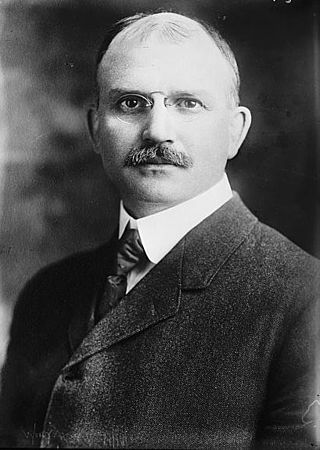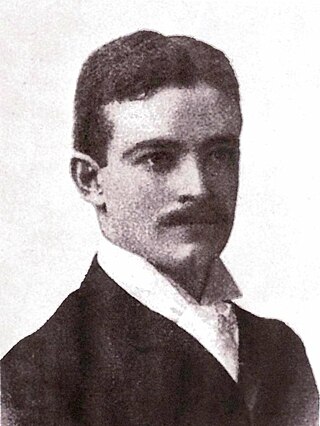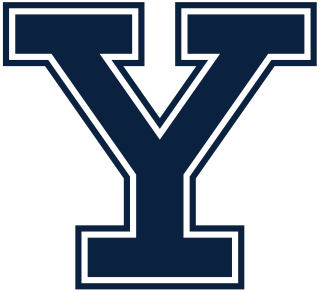
In gridiron football, an end is a player who lines up at either end of the line of scrimmage, usually beside the tackles. Rules state that a legal offensive formation must always consist of seven players on the line of scrimmage and that the player on the end of the line constitutes an eligible receiver. There are two types on offense: the split end, or wide out, and the tight end. On defense, there is simply the defensive end. It is also used in terminology such as an end run.

William Walter "Pudge" Heffelfinger, also spelled Hafelfinger, was an American football player and coach. He is considered the first athlete to play American football professionally, having been paid to play in 1892 for the Allegheny Athletic Association.

George Washington Woodruff was an American college football player, rower, coach, teacher, lawyer and politician. He served as the head football coach at the University of Pennsylvania (1892–1901), the University of Illinois at Urbana–Champaign (1903), and Carlisle Indian Industrial School (1905), compiling a career college football record of 142–25–2. Woodruff's Penn teams of 1894, 1895, and 1897 have been recognized as national champions. Woodruff was inducted into the College Football Hall of Fame as a coach in 1963.

Knowlton Lyman "Snake" Ames was an American football player and coach. He played for Princeton University from 1886 to 1889, and the Chicago Athletic Association, in 1892. Playing for the Princeton Tigers, Ames was selected to the 1889 College Football All-America Team as a fullback. In 1891 and 1892, he was the head football coach at Purdue University. He is also credited as the first head football coach at Northwestern University.

Hector William "Hec" Cowan was an American college football player and coach, and an ordained Presbyterian minister. He played football at Princeton University from 1885 to 1889. He was team captain for Princeton and selected to the first College Football All-America Team in 1889. Cowan served as the head football coach at the University of North Carolina at Chapel Hill for Carolina's two games in the spring of 1889, and at the University of Kansas from 1894 to 1896, compiling a career coaching record of 18–8–1. He was inducted into the College Football Hall of Fame as a player in 1951.

The Yale Bulldogs football program represents Yale University in college football in the NCAA Division I Football Championship Subdivision. Yale's football program, founded in 1872, is one of the oldest in the world. Since their founding, the Bulldogs have won 27 national championships, two of the first three Heisman Trophy winners, 100 consensus All-Americans, 28 College Football Hall of Fame inductees, including the "Father of American Football" Walter Camp, the first professional football player Pudge Heffelfinger, and coaching giants Amos Alonzo Stagg, Howard Jones, Tad Jones and Carmen Cozza. With over 900 wins, Yale ranks in the top ten for most wins in college football history.

The 1890 College Football All-America team was the second College Football All-America Team. The team was selected by Caspar Whitney and published in This Week's Sports.
The 1891 College Football All-America team is composed of college football players who were selected by Caspar Whitney as the best players at their positions for the 1891 college football season. Whitney began publishing his All-America Team in 1889, and 1891 was the first year Whitney's list was published in Harper's Weekly.

Arthur James Cumnock was an American college football player. He and Amos Alonzo Stagg were selected as the ends on the first College Football All-America Team in 1889. Cumnock invented the first nose guard. He is also credited with developing the tradition of spring practice in football; in March 1889, Cumnock led the Harvard team in drills on Jarvis field, which is considered the first-ever spring football practice.

William Castle Rhodes was American football player and coach. Rhodes played tackle at Yale University from 1887 to 1890 and was selected for the 1890 College Football All-America Team. After playing for the Cleveland Athletic Club and coaching at Western Reserve in 1891, Rhodes returned to his alma mater to serve as head coach for the Yale Bulldogs football team in 1893 and 1894, compiling a record of 26–1. Rhodes' 1894 team won all 16 of its games and was later recognized as a national champion by a number of selectors.
Benjamin Shenstone "Sport" Donnelly was an American football player and coach. He was the second-ever known professional football player, after Pudge Heffelfinger. He was paid $250 for one game on November 19, 1892 by the Allegheny Athletic Association, for a game against the Washington & Jefferson Presidents football team. The November 19 date was exactly seven days after the team paid Heffelfinger $500 for a game. In 1893, Donnelly was hired by the Allegheny Athletic Association as player-coach, making him the first man to ever coach a known pro team. Heffelfinger once said that Donnelly was the only man that he had played against who "could slug you and at the same time keep his eyes on the ball". Donnelly also served as the second head football coach at the University of Iowa for a single season in 1893, compiling a record of 3–4.

The Chicago Athletic Association was a men's club and American football team, based in Chicago, Illinois. The club itself had been organized in 1890, and in 1892 it formed a football team. The team was built around veterans of Chicago's University Club football team. The team played for seven seasons.

The 1889 college football season was the season of American football played among colleges and universities in the United States during the 1889–90 academic year.

The 1891 college football season was the season of American football played among colleges and universities in the United States during the 1891–92 academic year.

The 1890 college football season was the season of American football played among colleges and universities in the United States during the 1890–91 academic year.

The Poe brothers were six American football players who played football at Princeton University from 1882 until 1901. They were sons of John P. Poe Sr., an 1854 Princeton graduate and the Attorney General of Maryland from 1891 until 1895. They were also second cousins, twice removed, of the poet and short story writer Edgar Allan Poe, who died in 1849.

The 1889 Princeton Tigers football team was an American football team that represented Princeton University as an independent during the 1889 college football season. The team compiled a perfect 10–0 record, shut out six of ten opponents, and outscored all opponents by a total of 484 to 29. The team captain and quarterback was Edgar Allan Poe, the second cousin of his namesake, the writer Edgar Allan Poe.

The 1888 Yale Bulldogs football team represented Yale University in the 1888 college football season. In its first season under head coach Walter Camp, the team compiled a 13–0 record, did not allow a single point, and outscored opponents by a total of 694 to 0. The team has been retrospectively named as the national champion by the Billingsley Report, Helms Athletic Foundation, Houlgate System, National Championship Foundation, and Parke H. Davis.

The 1891 Yale Bulldogs football team represented Yale University in the 1891 college football season. The team finished with a 13–0 record and a 488-0 season score. It was retroactively named as the national champion by the Billingsley Report, Helms Athletic Foundation, Houlgate System, National Championship Foundation, and Parke H. Davis. Yale's 1891 season was part of a 37-game winning streak that began with the final game of the 1890 season and stopped at the end of the 1893 season.
The 1889 Yale Bulldogs football team represented Yale University in the 1889 college football season. In their second season under head coach Walter Camp, Yale compiled a 15–1 record, held opponents scoreless in 12 games, and outscored all opponents by a total of 659 to 31. Its only loss was in the final game of the season against rival Princeton by a 10–0 score.























